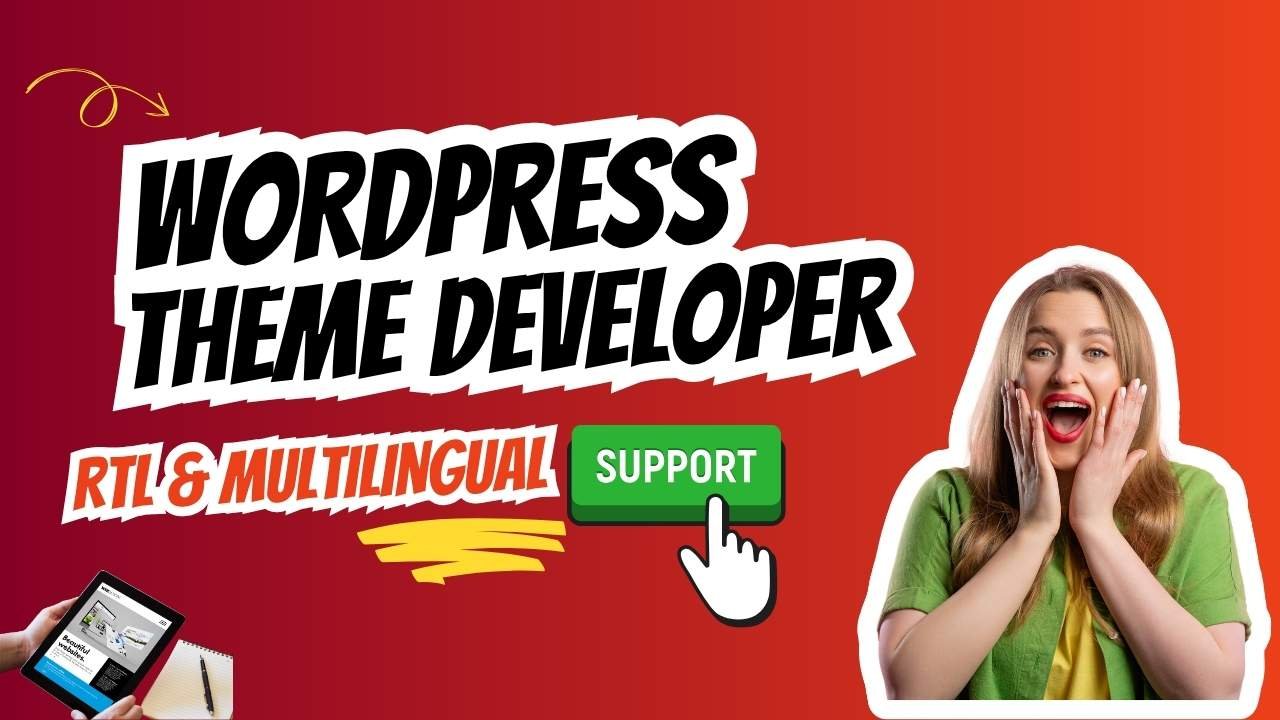Ensure your WordPress theme supports RTL and multilingual users. Learn how to implement RTL stylesheets, integrate translation-ready templates, handle child themes, performance, SEO, and global UX for developers.
Introduction
In today’s global web-landscape, the ability of a WordPress theme to support both multilingual content and Right-to-Left (RTL) languages is no longer optional—it’s a key differentiator. As a theme developer, ensuring your product is translation-ready and RTL-compatible opens you up to markets in the Middle East, Asia, Europe, and beyond. According to guides from WPML, you should treat RTL support as more than “nice to have”. Resources like WPBeginner highlight that although many themes claim multilingual readiness, true support for RTL scripts like Arabic, Hebrew, ew, and others is still inconsistent.
In this article, we’ll cover what you must know—technical requirements, best practices, pitfalls, performance & SEO considerations—and answer the top questions developers ask when building or selling themes with RTL & multilingual support.
1. Translation-Ready vs Multilingual vs RTL: Clarifying the Terms
- Translation-ready means your theme uses WordPress’s internationalisation functions (__(), _e(), etc) and bundles .pot, .po, .mo files. A translation-ready theme is the baseline.e
- Multilingual support goes further: The theme works well with plugins like WPML or Polylang and handles multiple languages in different contexts (pages, posts, widgets, menus).
- RTL support means the layout and CSS of the theme properly handle right-to-left scripts (Arabic, Hebrew, Urdu, etc). That means flipped floats, mirrored UI, correct typography, and appropriate direction settings. A robust theme should ideally support all three. If you skip RTL, you limit usability for large linguistic markets—and risk losing credibility for “global ready” claims.
2. Technical Requirements for RTL & Multilingual Support
Internationalisation (i18n) & localisation (l10n)
Ensure all text strings are wrapped:
_e( ‘Theme options’, ‘your-theme-textdomain’ );
Load text-domain in functions.php:
load_theme_textdomain( ‘your-theme-textdomain’, get_template_directory() . ‘/languages’ );
.
RT L Stylesheet
WordPress recognises rtl.css (or style-rtl.css) to override the default left-to-right (style.css) layout.
In functions.php, enqueue properly:
wp_enqueue_style( ‘theme-rtl’, get_template_directory_uri() . ‘/rtl.css’, array( ‘theme-style’ ), ‘1.0’, ‘all’ );
wp_style_add_data( ‘theme-rtl’, ‘rtl’, ‘replace’ );
Fluid & Responsive Layouts
RTL languages may occupy more width due to character complexity; ensure your breakpoints, container widths, and grid systems remain intact.
Widget Areas, Sidebars & Navigation
If you have a sidebar on the left in LTR, in RTL it might need to appear on the right. Menu icons/arrows should point the correct way in RTL.
Handles for Multilingual Plugins
Ensure your theme doesn’t hard-code language in menus, and supports features like language switchers, translation of custom text, and custom-menu duplication for each language.
Fonts & Typography
RTL scripts often require different fonts or font families optimized for Arabic/Hebrew. Make sure your theme offers fallback fonts and loads Unicode-friendly ones.
Testing & Debugging
Test your theme with an RTL language (in wp-config.php set WPLANG=’ar’ for Arabic) and ensure front-end, menu, theme options panel, and Gutenberg blocks all render appropriately
Use plugins like “RTL Tester” for quick mirroring of the layout.
3. Best Practices for Theme Developers
- Provide both style.css and rtl.css or use tools like RTLCSS to generate mirrored styles.
- In your theme.json or customizer, expose typography and color presets that work for RTL.
- Use semantic HTML and avoid absolute positioning and fixed floats when possible (those break in RTL).
- In your demo content and documentation, include RTL screenshots and show multilingual switchers.
- Ensure compatibility with major translation plugins (WPML, Polylang, Weglot) — mention this clearly in your theme description.
- Make sure blocks in the block editor(Gutenberg) also behave in RTL (alignments, margins, nested blocks).
- Provide child-theme compatibility – allow users to override both LTR/RTL styles without hacking core files.
- Check performance: heavy fonts or large locale files can slow page loads — aim for size-efficient translations and font-loading strategy.
- Document clearly: “How to enable RTL” section, "how to add new language", "how to test translation plugin compatibility".
- Monitor feedback from RTL language users and keep your theme updated as languages evolve.
4. SEO & UX Considerations for Multilingual & RTL Sites
- Use hreflang tags for different language versions of pages to help search engines serve the correct version to users.
- Ensure your theme supports rich metadata and doesn’t duplicate content across languages — each language version should be unique.
- Load language switchers in a visible but unobtrusive way; this helps UX and lowers bounce.
- For RTL audiences, ensure readability: appropriate font size, line-height, and sufficient contrast because script shapes differ.
- Keep mobile usability strong: many RTL markets (e.g., Arabic, Urdu) have very high mobile usage; responsive menu and layout are key.
- Avoid hidden or duplicate-content translation widgets that auto-translate without semantic tagging — Search engines may penalize poor translations.
- Use URL structures like example.com/ar/ for Arabic, example.com/he/ for Hebrew, so users and search engines understand language segmentation.
- Make sure your theme supports canonical URLs, and translation plugins are compatible, so you don’t end up with separate indexes of the same content in different languages, causing SEO issues.
5. Common Pitfalls & How to Avoid Them
- Theme lacks rtl.css: The site may display, but with a broken layout (floats wrong way, icons misplaced). Always provide an RTL stylesheet.
- Hard-coded text strings: If the theme uses hard-coded English strings, they won’t be translated — failing i18n.
- Missing language switcher/menu duplication: Users may not find how to switch languages, harming UX.
- Over-reliance on custom fonts that lack RTL script support: Use fallback fonts.
- Testing only in LTR: If you don’t test in RTL, you’ll miss many UI problems.
- Performance issues: Some translation-ready themes load unnecessary locale files even if the user uses one language—opt for selective loading.
- SEO duplication: Without proper hreflang and canonical setup, multilingual content can appear as duplicate content.hemes load unnecessary locale files even if the user uses one language—opt for selective loading.
- Ignoring admin/back-end UI in RTL: If your theme options panel or metaboxes appear broken in RTL admin screens, that diminishes professionalism. (See WPML guidance)
6. Marketplace Impact & Why Developers Should Care
- By supporting RTL + multilingual, your theme addresses a much larger global market (the Middle East, North Africa, South Asia, and diaspora communities).
- Demonstrating capability elevates your theme’s credibility—many blogs and lists about “best RTL WordPress themes” highlight this.
- Clients (agencies) increasingly ask for multilingual/RTL support when building sites; by offering it, you can capture more professional projects and higher price brackets.
- From a future-proofing perspective, globalisation and localisation are growing trends—sites will need to cater to multiple languages; early support gives you a head-start.
- SEO-wise, multilingual sites influence domain authority and can drive traffic from non-English markets you hadn’t yet tapped.
Conclusion
For theme developers aiming at quality, global-ready products, building in RTL and multilingual support is a must. From the technical requirements of RTL stylesheets and internationalisation hooks to best practices around fonts, layout flipping, plugin compatibility, SEO, and performance—this is a set of competencies that distinguish average themes from world-class ones.
By following the guidance above, you’ll ensure your theme is fully usable and polished for languages that read both Left-to-Right and Right-to-Left, boosting your market reach, supporting global clients, and enhancing your reputation in international WordPress ecosystems.
Top 10 FAQs
-
What does “RTL support” mean in a WordPress theme? It means the theme’s layout, CSS, and UI can correctly display languages that flow from Right to Left (such as Arabic and Hebrew) by flipping the direction, repositioning elements, and supporting appropriate typography.
-
Do I still need to include rtl.css if I use a translation plugin? Yes. Translation plugins handle text strings and content, but the theme must include an RTL stylesheet so the layout flips and UI aligns properly.
-
How can I test a theme for RTL compatibility? Change the site language in WordPress settings to an RTL language (e.g., Arabic). Then check the front-end and admin panels: navigation, layout, buttons, sidebars, fonts, and directionality.
-
Is translation-ready the same as multilingual? No. Translation-ready means the theme uses the proper internationalisation hooks and text-domains. Multilingual means the theme works well with multiple languages/sites with language switchers and is SEO compatible.
-
Which plugins are best for multilingual support? Popular ones include WPML, Polylang, ng, and Weglot. Themes should mention compatibility. For example, Weglot recommends certain themes for business sites.
-
What about fonts—are they different for RTL languages? Yes. RTL scripts often require fonts optimized for those scripts. Make sure your theme provides fallbacks and loads appropriate font subsets.
-
Will supporting RTL affect performance? It can if you bundle large styles or fonts without optimisation. Use conditional loading, selective font subsets, and minified CSS for RTL to keep performance high.
-
How do I handle SEO for multilingual sites? Use proper URL structure (e.g., /en/, /ar/), implement hreflang tags, avoid duplicate content, ensure translations are high quality and unique, and make sure each language version is indexable.
-
Can I support both LTR and RTL on the same site? Yes—WordPress supports site languages dynamically. With proper theme RTL support and language switchers, you can offer both. But you’ll need to test both directions thoroughly.
-
What are the biggest mistakes developers make with RTL/multilingual themes? Providing only a translation-ready but no RTL stylesheet. Hard-coding text strings rather than using text domains. Not testing the admin/back-end in RTL. Ignoring menu/sidebar flipping and layout direction. Overlooking SEO for multilingual setup (missing hreflang, duplicate content).

Monetising WordPress Themes & Plugins: Licence Models, Free-vs-Pro Strategy & Affiliate Marketing
Read More »
Theme Security Best Practices: Protecting Your Users and Building a Trusted Brand (2025 Edition)
Read More »





Leave a Reply